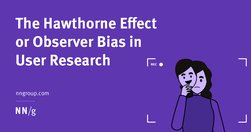Relevant Overviews

Each product has a unique user base with distinct behaviors and preferences. Applying generic strategies without understanding the specific user base is like trying to solve a puzzle while blindfolded.

Individuals often modify their behavior if they know they are being observed. That phenomenon became known as the Hawthorne effect or the observer bias. We can mitigate this effect by building rapport, designing natural tasks, and spending more time with study participants.

A myriad of fields, skills and insights come together to create the overarching discipline of user experience design... Let’s explore five behavioral science insights you can use right now to design better products
"understand the digital reader’s brain, and to get a couple of concrete writing tips for your next digital text." "Nothing can surpass a text when it comes to transforming abstract thoughts into concrete expression."

“Daily political events consistently evoked negative emotions [which] predicted worse day-to-day psychological and physical health, but also greater motivation to take action aimed at changing the political system that evoked the negative emotions in the first place.”

From now, house style guide recommends terms such as ‘climate crisis’ and ‘global heating’

"behavioral science provides several insights into habits we might adopt to increase our joy and happiness—almost instantaneously."